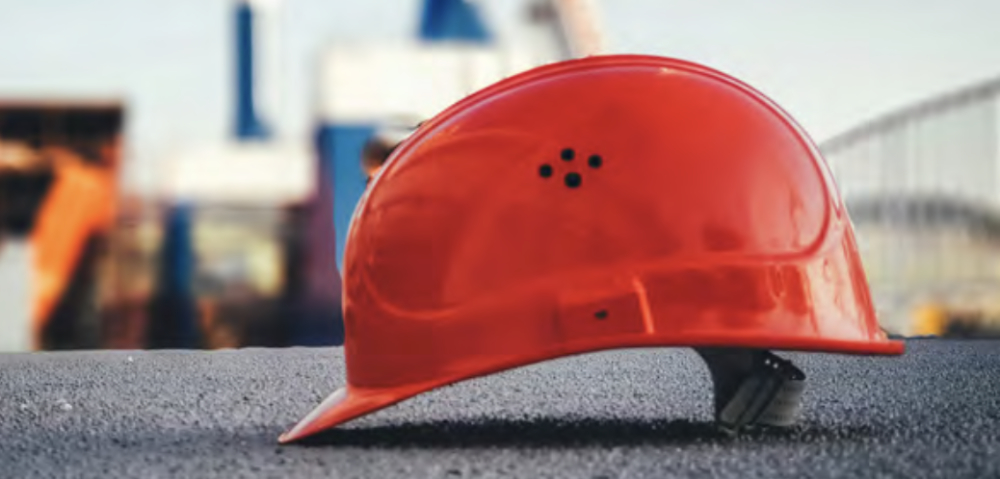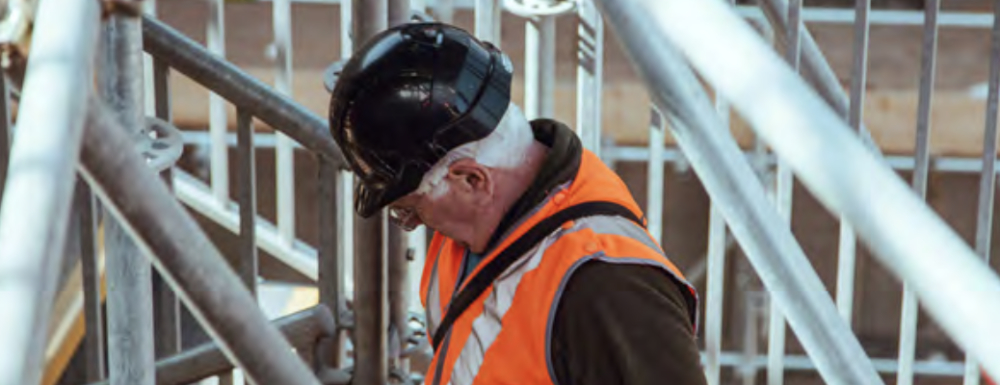Picking up the hard hat on site or not...
Contents |
[edit] Common factors preventing workers using head protection and how to solve them
Wearing a hard hat is mandatory in many applications and industries, protecting the safety of individuals in potentially hazardous environments. But wearing PPE can be seen by users as a hindrance rather than an important safety feature for their workday.
This is typically the learned experience of industrial professionals who have at times found that some hard hats can bring on headaches, make them hot and sweaty, or often do not fit properly. At MSA Safety, we believe that the most effective hard hat is the one a worker will want to wear.
A more comfortable helmet can not only empower workers, but can also make them feel safer and happier, improve their productivity and even boost their confidence, allowing them to better focus on the job at hand.
To understand what makes a great hard hat, we need to dissect some key issues associated with common protective headwear solutions on the market today and find out what exactly is deterring users from wearing this vital piece of protective equipment correctly. We outline some of the most common factors which could hinder correct usage of hard hats on site, and how selecting the appropriate hard hat can help to reduce this.
[edit] Temperature regulation
From construction professionals operating outside in the scorching heat to mechanical specialists contracted to conduct works in boiler rooms, many industrial workers find themselves carrying out demanding jobs in incredibly warm environments. The combination of heat and physical exertion can make wearing personal protective equipment (PPE) extremely uncomfortable if the appropriate hard hat has not been selected for the workers.
Hard hats can be warm; they trap sweat and perspiration can make them fog. To help reduce this, helmets with ventilation should be opted for. These helmets can be adapted to improve comfort. Also, sweatbands made from a soft, sweat-absorbing and respiring material can be incorporated, washed and replaced.
Accessories can also be incorporated in aiding workers’ comfort during winter months or in colder environments, in which wearing hard hats can be just as uncomfortable. Winter liners can assist with temperature regulation, helping to protect workers from the cold and keep them warmer. In addition, for those working outdoors, helmets with integrated rain gutters may be more practical for workers, ensuring water drains off the bill rather than down the wearer’s neck.
From boiling to freezing, the type of environment your workers are operating in is an essential factor to consider when choosing the appropriate hard hat for your workers.
[edit] All day comfort
If protective hard hats do not have a good fit and appropriate straps to keep them in place, they can slip, slide and move around, becoming a distraction for workers.
Understandably, this is a top factor that contributes to workers not wearing their hard hat when needed. Indeed, if a helmet slips down, vision may be impaired, and if it needs to be adjusted at a critical moment then potentially dangerous tools may not be under a worker’s full control.
Thankfully, there are ways to solve this problem. A six-point ratchet textile suspension will contribute to comfort, enabling the helmets to be adjusted to fit a range of head sizes and genders, thus providing an inclusive and secure fit. This will minimise rattling and slippage, even when users are repeatedly looking around. Equally, a four-point textile chinstrap can reinforce the retention of the helmet on your head.
While comfort, at least in part, stems from temperature regulation and fit, the actual feel of the helmet against your head is also crucial. For this reason, soft textile straps and good suspension is invaluable. An effective hard hat should also prevent hair pulling and compression headaches, facilitate good airflow and feature a quality ratchet system for quick, smooth and reliable adjustments.
[edit] Appropriate for work applications
Ultimately, hard hats become an extension of your head during the workday. And, in cases of confined or restrained spaces, smaller equipment is often more practical. In these applications users can look to acquire models that have a modern dynamic design with a low-profile, compact, sports-styled shell and no protruding peaks.
Of course, the solution depends on the application. Short peak or peak-less safety helmets can be better for workers requiring good upwards visibility, yet standard peaks are better for protecting your eyes from the sun. Non-vented shells should always be used in environments where chemicals or hot liquids may be projected.
It is also important to consider the accessories that are appropriate for certain applications, movements and tasks. If it is hard to tweak the sizes and straps, any additional features will add little value and may go unused. It is important that users can easily adjust the size of their hard hat for a secure fit, even when wearing safety gloves.
[edit] Aesthetics
It is not always just a case of what a helmet feels like, but what it looks like too. People like to look their best, whether that be in their personal lives or at work. This attachment can help the worker take better care of their protective headwear, which extends the lifespan of each model and makes product investments go further.
When considering aesthetics, a safety helmet that has a modern, low-profile sporty design is likely to be more desirable than larger, chunkier alternatives. Despite this, you should always look to prioritise the level of protection; safety should never be compromised for style.
[edit] How to choose the right hard hat for you
There are a diverse range of factors to consider, from suspension, soft textile materials, vented or non- vented models, to heat regulation accessories, size and aesthetics.
Appropriately selecting the model and relevant accessories can provide many benefits. Not only can the right hard hat help to improve the safety of your staff, but it can also increase confidence, contribute to a happier workforce, and boost productivity by enabling workers to work more efficiently.
This article appears in the AT Journal issue no 150, summer 2024 as 'Picking up the hard hat: common factors preventing workers using head protection and how to solve them' and was written by MSA Safety, images supplied.
--CIAT
[edit] Related articles on Designing Buildings
- Achieve safety in demolition.
- Asbestos.
- CDM.
- CIAT articles.
- CIOB People, PPE that fits campaign.
- CIOB urges construction industry to share PPE with healthcare providers.
- Cold stress.
- Construction dust.
- COSHH.
- Deleterious materials.
- Demolition.
- Dynamic self-retracting lanyard.
- Face coverings.
- Filtering facepieces.
- First aider.
- Fit testing.
- Getting personal about protective equipment.
- Hazardous substances.
- Health and safety.
- Health and safety for building design and construction.
- Heat stress.
- Hi-vis clothing.
- How to keep workers safe around machinery.
- Method statement.
- New domestic electrical work video.
- Noise at Work Assessment.
- Occupational health.
- Pandemic safety for on-site accommodations.
- Personal Protective Equipment PPE.
- PPE regulations 2022.
- Risk assessment.
- Safety briefing.
- Safety helmet colours.
- Personal protective equipment PPE.
- The Personal Protective Equipment at Work Regulations 1992.
- Toolbox talk.
- Workplace noise exposure estimator.
- Workplace safety supplies.
Featured articles and news
50th Golden anniversary ECA Edmundson apprentice award
Showcasing the very best electrotechnical and engineering services for half a century.
Welsh government consults on HRBs and reg changes
Seeking feedback on a new regulatory regime and a broad range of issues.
CIOB Client Guide (2nd edition) March 2025
Free download covering statutory dutyholder roles under the Building Safety Act and much more.
AI and automation in 3D modelling and spatial design
Can almost half of design development tasks be automated?
Minister quizzed, as responsibility transfers to MHCLG and BSR publishes new building control guidance.
UK environmental regulations reform 2025
Amid wider new approaches to ensure regulators and regulation support growth.
The maintenance challenge of tenements.
BSRIA Statutory Compliance Inspection Checklist
BG80/2025 now significantly updated to include requirements related to important changes in legislation.
Shortlist for the 2025 Roofscape Design Awards
Talent and innovation showcase announcement from the trussed rafter industry.
OpenUSD possibilities: Look before you leap
Being ready for the OpenUSD solutions set to transform architecture and design.
Global Asbestos Awareness Week 2025
Highlighting the continuing threat to trades persons.
Retrofit of Buildings, a CIOB Technical Publication
Now available in Arabic and Chinese aswell as English.
The context, schemes, standards, roles and relevance of the Building Safety Act.
Retrofit 25 – What's Stopping Us?
Exhibition Opens at The Building Centre.
Types of work to existing buildings
A simple circular economy wiki breakdown with further links.
A threat to the creativity that makes London special.
How can digital twins boost profitability within construction?
The smart construction dashboard, as-built data and site changes forming an accurate digital twin.



























